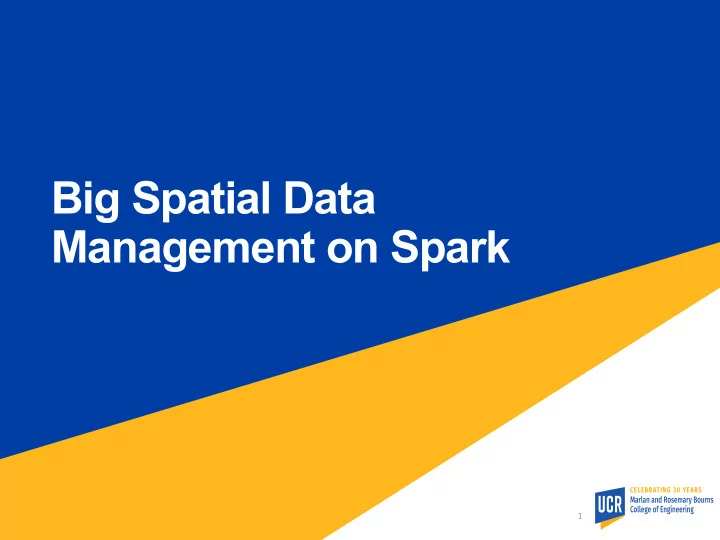

Big Spatial Data Management on Spark 1
Tons of Spatial data out there… Geotagged Pictures Geotagged Microblogs Sensor Networks Medical Data Smart Phones Satellite Images Traffic Data VGI 2
Beast • A Spark add-on for Big Exploratory Analytics on Spatio-Temporal data • Developed at UCR § You will get high-quality support J • Already used in UCR-Star and other live applications 3
Geometry Data Types Point LineString Polygon MultiPoint MultiLineString MultiPolygon GeometryCollection 4
Geometry Predicates A A Contains B C B A Overlaps C B Disjoint C A Touches D D 5
Geometric Analysis Functions • Create Point, LineString, … • Intersection, Union, Difference • Area, Length • Centroid, Convex Hull 6
Spatial Feature (IFeature) Feature = Geometry + Other Attributes • Example § Road(Geometry, Name, Speed Limit) § State(Geometry, Name, Population) • SpatialRDD = RDD[IFeature] or JavaRDD<IFeature> 7
Data Source • UCRStar.com • Spider.cs.ucr.edu • 200+ datasets • Still beta • Full/subset • Data generator download • Standard formats 8
Spatial Functions in Spark • Data loading • Simple manipulation • Summarization • Partitioning • Range filters • Spatial join • Visualization 9
Project Setup pom.xml <dependencies> <dependency> <groupId>edu.ucr.cs.bdlab</groupId> <artifactId>beast-spark</artifactId> <version>0.8.2</version> </dependency> </dependencies> App.scala import edu.ucr.cs.bdlab.beast._ 10
Data Loading // Load a shapefile val polygons: RDD[IFeature] = sc.shapefile("tl_2018_us_state.zip") // Load GeoJSON file val points = sc.geojsonFile("Tweets.geojson") // Load points from a CSV file val lines = sc.readCSVPoint("Crimes.csv", "Longitude", "Latitude", ',', skipHeader = true) // Load geometries from a CSV file val lines = sc.readWKTFile(”States.csv", 0, '\t', skipHeader = false) 11
Simple Manipulation // Calculate the area and append as a new attribute polygons.map(f => { val area = f.getGeometry.getArea val newF = new Feature(f) newF.appendAttribute("area", area) newF }) // Simplify the geometries into their convex hull polygons.map(f => { val ch = f.getGeometry.convexHull() val newF = new Feature(f) newF.setGeometry(ch) newF }) 12
Summarization // Calculate a simple summary for geometries val summary: Summary = polygons.summary println (summary) Output MBR: [(-179.231086, -14.601813), (179.859681, 71.439786)], size: 14807211, numFeatures: 56, numPoints: 924434, avgSideLength: [12.188812250000007, 4.276107500000001] 13
Histogram // Calculate a histogram of 100 x 100 val histogram = points.uniformHistogramCount( Array (100, 100)) println (histogram.getValue( Array (0, 0), Array (40, 10))) Output 482 14
Spatial Partitioning // Partition the dataset into 100 partitions using a uniform grid partitioner val partitionedPoints: RDD[(Int, IFeature)] = points.partitionBy( classOf [GridPartitioner], 100) // More balanced partitions val partitionedPoints: RDD[(Int, IFeature)] = points.partitionBy( classOf [RSGrovePartitioner], 100) 15
Range Filters // Select the geometry of the state of California val california: IFeature = polygons.filter(f => f.getAttributeValue("NAME") == "California").first() // Filter the points that are inside the state of California val californiaPoints = points.rangeQuery(california.getGeometry) println (s"Number of points in California $ {californiaPoints.count()}") Output Number of points in California 259657 16
Spatial Join // Count points per state val airportCountByState = polygons.spatialJoin(airports) .map(fv => (fv._1.getAttributeValue("NAME"), 1)) .countByKey() airportCountByState.foreach(sv => println (s" $ {sv._1}\t $ {sv._2}")) Output New Mexico 1 Connecticut1 Commonwealth of the Northern Mariana Islands 2 California 12 Nevada 3 17
Visualization // Plot states as an image polygons.plotImage(2000, 2000, "states.png") 18
Visualization on a Map // Plot states as a multilevel map polygons.plotPyramid("states", 10, opts = "mercator" -> "true") 19
Writing the output // Save the output as a decompressed shapefile polygons.saveAsShapefile("output.shp") // Save the output as a GeoJSON file polygons.saveAsGeoJSON("output.geojson") // Save as a WKT file polygons.saveAsWKTFile("output.tsv", 0, '\t') // Save points as a CSV file polygons.saveAsCSVPoints("output.csv", 0, 1, ',') // Save as KML file polygons.saveAsKML("output.kml") 20
Other Big Spatial Data Systems • Apache Sedona (Formerly GeoSpark) § Developed at ASU § In incubation [http://sedona.apache.org] • PySAL [https://pysal.org] § For Python users § Maintained by the Center for Geospatial Sciences at UCR 21
Summary • There are tons of big spatial data • Beast can help you processing big spatial data in Spark such as: § Loads data in standard formats § Manipulates feature attributes § Summarizes the data § Filters by range § Joins multiple datasets § Visualizes the results 22
Further Readings • Beast Wiki Pages § https://bitbucket.org/eldawy/beast/wiki/H ome • Code Examples § https://bitbucket.org/eldawy/beast- examples/src/master/ • Visualization Paper § Saheli Ghosh, Ahmed Eldawy, and Shipra Jais. AID: An Adaptive Image Data Index for Interactive Multilevel Visualization, ICDE 2019, DOI>10.1109/ICDE.2019.00150 23
Recommend
More recommend